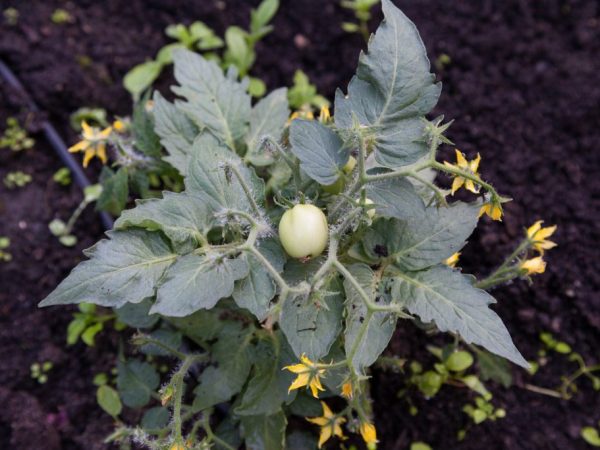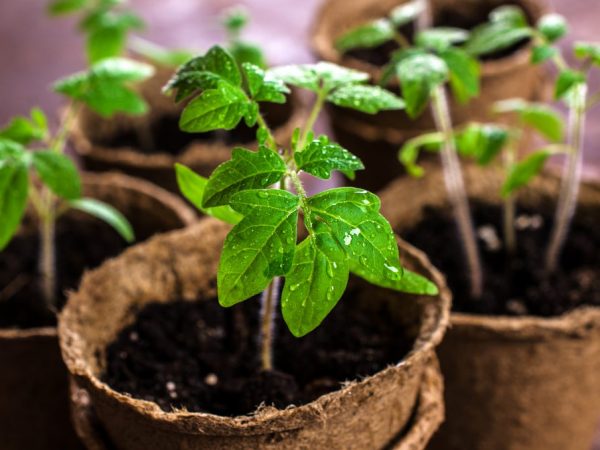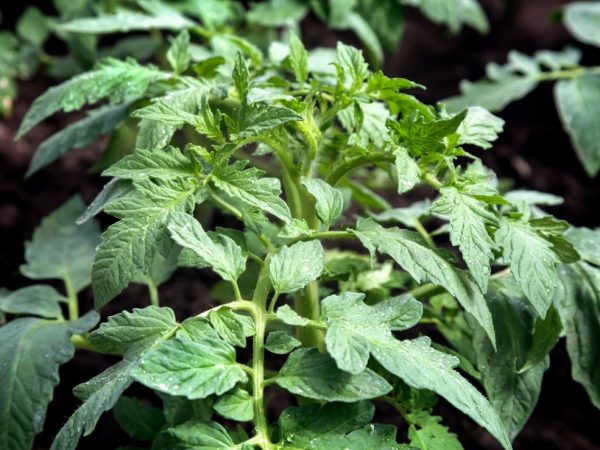Causes of purple tomato seedlings
Most gardeners, not trusting the purchased nightshade plants, prefer to sprout seed material on their own. And therefore, they often encounter such a phenomenon as purple tomato seedlings. Leaves or trunks of seedlings can have this shade. And there are situations when tomato seedlings are completely purple. To get rid of such an unusual color of plants, it is necessary to understand the reasons for this phenomenon.

Causes of purple tomato seedlings
Causes of the purple color of tomato leaves
Purple tomato seedlings can be found in only a few cases. The first reason is the wrong temperature regime. Another purple leaves or stem may be due to a lack of nutrients in the soil. This substance is phosphorus.
These two reasons are directly related. If the air temperature is lower than it should be, then the tomato will not be able to absorb phosphorus normally. This means that the leaves of the seedlings will turn purple.
The main reasons for being purple are:
- lack of phosphorus;
- low or too high temperature.
Why are tomato seedlings purple? The temperature regime for seedlings is correct and phosphorus is introduced into the ground clearly according to the scheme, and the leaves are still purple. Another reason why a tomato can have this shade is not enough light. In order for tomatoes to turn green leaves, you just need to provide them with additional lighting.
Symptoms of phosphorus deficiency in plants
The tomato constantly needs fertilization. Lack of nutrients leads to the fact that the culture may simply die. If the soil was not initially saturated with trace elements, the leaves of the seedlings from below become stunted and acquire a purple hue.
Lack of phosphorus is indicated by spots on the leaves.
Over time, the purple leaves begin to curl and stick to the trunk. The stem at this time becomes more rigid and brittle. With a lack of phosphorus in tomato seedlings, the roots begin to fade. If you do not saturate the plant with this useful substance, then it will simply die.
Phosphorus is used to feed tomatoes from the moment they are planted until they are fruitful. But it plays an important role in the period of active growth. When the seeds begin to germinate, this beneficial substance influences the formation of the roots. Also, phosphorus allows you to get the first harvest early and in a fairly large amount. Tomato seedlings accumulate the substance in themselves throughout the entire time and also consume it during the growth process.
Lack of phosphorus leads not only to the fact that the leaves of tomato seedlings become purple, but also to poor absorption of nitrogen. And this substance also plays an important role in the growth process of tomatoes.
Fertilizing tomato seedlings with phosphorus
In order for the purple leaves of tomato seedlings to acquire a pleasant green color, it is necessary to make up for the lack of phosphorus. This will allow:
- improve the condition of the root system;
- the leaves will turn green;
- fruits will begin to set early;
- you end up with delicious tomatoes.
But there are situations when phosphorus is not at hand, what to do then. In such cases, the plant can be helped by assisting with the use of a special infusion of dung and ash. For the first time, this seedlings will be enough, but you need to try to quickly acquire phosphorus.

Lack of phosphorus negatively affects seedlings
You can fill the lack of phosphorus only with the help of special preparations that are sold in any gardening store. Only such a substance can cope with this problem. Boric acid is often used for this. You can buy it at any pharmacy.
In gardening stores, you can find fertilizers saturated with phosphorus, of several types. The most popular are liquid and powder. If the tomato seedlings turn purple, then it is better to take a liquid product. Gardeners recommend using a fertilizer such as superphosphate.
It is versatile in use and is great not only for tomatoes, but also for other plants. It is possible to carry out top dressing with such a means at any period of crop growth.
We apply fertilizer correctly
It is worth applying fertilizers as carefully as possible, because a large amount of it can also negatively say on the growth of tomatoes. It is worth remembering that if you have already added superphosphate in a certain area, then you should not do this annually. After all, such a substance is contained in the soil for 2-3 years.
People who are engaged in growing tomato seedlings have a special table. It indicates how much and when it is worth feeding. After all, they are also not protected from the fact that the plant can acquire a purple hue. If you are not a professional, but just an amateur, then such calculations are useless for you.
For open ground, a dry mix is often used, which is applied in spring or autumn. One square meter requires only 40 grams of fertilizer. It is advisable to do this before the earth is dug up. But for seedlings, it is better to use a liquid product. To do this, you need to dilute 20 grams of the drug in 10 liters of water.
This mixture should be infused for 24 hours. Then you can safely process the seedlings. This will allow the plant to return green leaves in a short time. They become so within a few days after fertilization.
Air temperature and seedling lighting
It happens that the seedlings become purple not because of a lack of phosphorus, but because the air temperature in the room is lower than it should be. Tomatoes grow well at temperatures above 15 degrees with a plus sign. If it becomes lower, then the nutrients cannot be absorbed normally and the plant slowly dies. Purple foliage is the first sign of a lack of warmth.
In order to fix this trouble, it is necessary to transfer the seedlings to a warmer place. Also, plants can turn purple due to lack of lighting, especially in winter. To correct these two reasons at the same time, you can lay foil between the drawer and the armrest. It will provide additional lighting and protect the seedlings from the cold.
If after such manipulations the seedlings do not turn green, then you should choose another place for it. Plus, to carry out additional lighting. This should be done artificially using an LED lamp. After a certain period of time, you will notice how the tomatoes have turned to a beautiful green color.
Prevention measures

Seedlings need to be looked after correctly
In order for the seedlings not to acquire a purple color, it is necessary to properly care for it from the moment of planting. Tomatoes are vegetables that are used to warm and dry climates.Therefore, in order for them to grow and develop well, it is necessary to provide them with the following:
- good lighting;
- warmth;
- regular watering;
- airing;
- regular fertilization with phosphorus.
Tomatoes do not like soils that are too acidic. Also, do not plant plants too close to each other. As soon as the seeds have hatched and have grown a little stronger, they should be planted in different containers. A large amount of nitrogen in the soil can also lead to a variety of diseases.
The air temperature in the room should not be less than 15 degrees with a plus sign and not higher than 35. Tomatoes should also be watered clearly according to the scheme. After all, a lack of water will lead to drying out of the roots, and an excess of it will lead to decay. Also, tomato seedlings can be made more resistant to temperature extremes and phosphorus deficiency.
Strengthening tomato seedlings
To prevent tomato seedlings from turning purple, they can be strengthened. After all, the more powerful the seedlings, the less they succumb to various misfortunes. The strengthening process must be done even before the seeds are sown. For this, the seeds should be soaked in an epin solution. This is a tool that allows you to accelerate growth and develop resistance to temperature extremes and diseases.
It is also recommended to water the plant not with ordinary water, but with humate infusion. Only its concentration should be minimal. Humate should be diluted as follows:
- 1 teaspoon of the substance;
- a little boiling water;
- stir the mixture;
- add two liters of water to the container.
This solution should be diluted again before watering. 100 grams of diluted humate should be mixed with 1 liter of water. This scheme is used to water the seedlings once. The concentrate of this product can be stored for a long time.
If you take preventive measures and properly prepare the seeds before planting, then your seedlings will not turn purple. The main thing is to regulate the temperature regime and the amount of phosphorus in the soil.
Conclusion
Anyone who has ever been involved in growing tomato seedlings has encountered such a problem when the leaves turn purple. In fact, this is not such a big problem if fixed in time. Timely assistance to the plant will not only save it, but also get a good harvest in the future. Practice shows that foliage is painted in such a color due to the fact that all planting rules were not followed.
Therefore, in order not to face such a problem, it is necessary to initially study how to plant tomatoes correctly. And then, how to properly care for them. Without these two components, you cannot get a beautiful, powerful, green seedlings.


